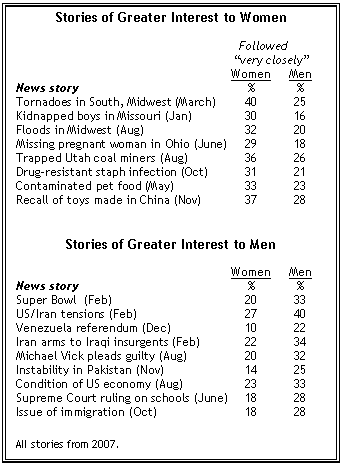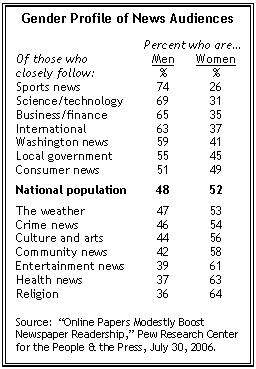A look at the public’s news interests over the past year shows continuing differences between women and men in the types of news stories that they follow very closely. Women consistently express more interest than men in stories about weather, health and safety, natural disasters and tabloid news. Men are more interested than women in stories about international affairs, Washington news and sports.

At the same time, men and women often express comparable levels of interest in the top news stories of the day. For example, the presidential campaign has attracted only modestly greater interest among men than among women. In five weekly news interest surveys in 2008, 37% of men and 32% of women say they have followed campaign news very closely.
Yet there are substantial gender differences in news about several subjects. Weather news was of particular interest to women: in 2007, 37% of women, on average, followed weather-related stories very closely compared with 29% of men. The largest gender difference in interest in any news story last year was for the tornadoes and violent storms that hit the South and Midwest in March. Four-in-ten women followed this story very closely compared with only 25% of men. Floods in the Midwest in August also attracted a much larger female audience — 32% of women compared with 20% of men followed this story very closely.
Women also expressed a particular interest in health and safety issues this past year. One of the biggest gaps was on news about a drug-resistant staph infection. Driven largely by interest among women, news of the staph infection was the public’s most closely followed story the week of Oct. 14. More than three-in-ten women (31%) followed this story very closely compared with 21% of men.
For several of the major health and safety stories of 2007, news coverage lagged behind public interest. In the case of the drug resistant staph infection, the national news media devoted 3% of its overall coverage to this story, making it the ninth most heavily covered story of the week, according to the Project for Excellence in Journalism. Two product recall stories also received broad interest from women in spite of limited media coverage: the recall of contaminated pet food in May and the recall of Chinese-made toys in November.
In addition to weather and safety stories, women were more interested than men in high-profile crime stories and tabloid news. When two kidnapped boys were found safe in Missouri in January, 2007, 30% of women followed the story very closely compared with 16% of men. And women consistently followed the biggest tabloid story of the year — the death of Anna Nicole Smith — more closely than did men. In mid-February, women were more than twice as likely to list Smith’s death as their most closely followed story (22% vs. 10%). Younger women were especially hooked on the story — 29% of women under age 50 listed this as their top story.
Men Dominate Sports Audience

The gender gaps in interest for individual news stories over the past year generally reflect broad differences in the news topics that men and women follow. Pew’s 2006 news consumption survey showed that men particularly dominate the audience for sports news, comprising 74% of this audience. In addition, the audiences for news about science and technology, business and finance, and international developments all are more than 60% male.1
By contrast, women make up more than 60% of the audience for news about religion, health and entertainment, and nearly as great a proportion of the audience for local or community news (58%). They also are disproportionately represented among those who closely follow news about culture and the arts.
The review of public interest in news stories is consistent with these patterns, though there are important exceptions. For example, of the 15 stories last year with the largest gender gap in favor of men, nearly half were stories dealing with international affairs. When tensions flared between the U.S. and Iran in February, 40% of men followed the story very closely compared with 27% of women. Similarly, men paid closer attention to political instability in Pakistan.
Yet there were no gender differences in interest about the assassination of former Pakistani Prime Minister Benazir Bhutto earlier this year; 33% of men and 32% of women followed news about this story very closely. Bhutto’s murder attracted a relatively high level of public interest for an international news story — it was the second most closely followed story during the week of Dec. 30, 2007.
Several stories dealing with policy issues and the inner workings of Washington attracted more interest from men than women. While 28% of men paid very close attention to the Supreme Court’s ruling on the role of race in public school placement, only 18% of women followed this story very closely. Men also paid closer attention to the Justice Department scandal involving the firing of eight U.S. attorneys (24% of men vs. 15% of women were following this story very closely in March).
News Sources and the Gender Gap

Not only do women and men follow different types of news stories, they go to different places for their news. According to the 2006 news consumption survey, women are more likely than men to regularly watch network morning shows — 28% of women and 17% of men regularly watch the Today Show, Good Morning America or the Early Show. Women are also more likely than men to watch the nightly network news (31% vs. 25% watch regularly) and network TV news magazines such as 60 Minutes and Dateline (25% vs. 21% regularly).
Men, on the other hand, are more likely than women to get their news from the radio — either radio news or talk radio. Men also use online news sources more often than do women. And more men than women read the newspaper regularly.
Notes
1 Online Papers Modestly Boost Newspaper Readership, July 30, 2006




